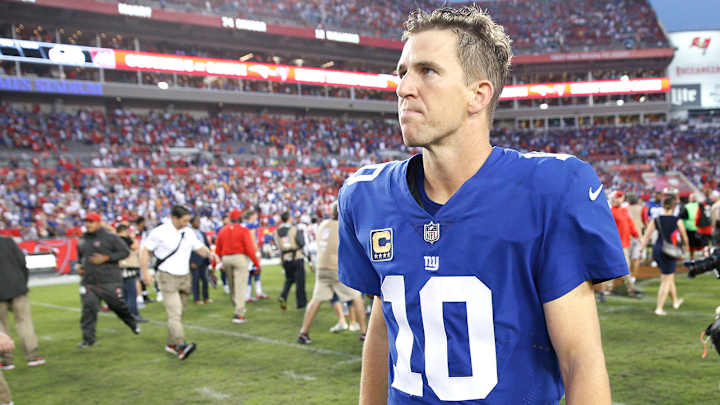The Giants’ Problems Aren’t New, the Losses Are

When Bucs kicker Nick Folk’s 34-yard field goal sneaked inside the left upright as time expired, the Giants fell to 0-4—3 ½ games out in the NFC East. Yes, there’s nothing wrong with the Giants. Or, more precisely, there’s nothing wrong this year that wasn’t wrong last year.
The difference between the 2017 Giants and 2016 Giants is that the 2017 Giants happen to be losing. After Weeks 1 and 2, New Yorkers were lambasting the Giants’ offensive line. But that offensive line had the same players and problems in ’16. Left tackle Ereck Flowers’s pass-blocking technique did not just deteriorate over the summer. The Giants’ right tackles did not become unathletic overnight.

In ’16, New York’s O-line woes were masked by Ben McAdoo’s quick-strike system; when the protection broke down, Eli Manning had already thrown the ball. McAdoo’s system occurred almost entirely out of static three-receiver formations. Fearing—correctly—that this made his offense easy to plan for, McAdoo installed more two-tight end and two-back packages early this season. H-back Rhett Ellison was the new piece, and we saw more schematic diversity from the Giants in Weeks 1 and 2. But this transition, coupled with Odell Beckham Jr.’s preseason ankle injury, made for a choppy passing game, exposing the bad offensive line.
McAdoo returned to the static three-receiver formations in Week 3 at Philadelphia. At least in that approach the ball could get out quickly. It did, and eventually the Giants rolled, but not until the fourth quarter, when they scored all 24 of their points. Unfortunately, the Eagles had 27, with their final three coming at the buzzer (on rookie kicker Jake Elliott’s 61-yarder). With Folk’s kick on Sunday, it became back-to-back losses on kicks as time expired.
The Giants’ formations were not quite as static against the Bucs as they’d been against Philly. Instead, McAdoo played with more two-tight end sets. But first-round rookie Evan Engram is as finesse a receiving tight end as you’ll find, and his deployment was essentially that of a third wide receiver. Engram performed well, and so did his quarterback (Manning: 30-49, 288 yards, 2 passing TDs plus one of his “vintage” TD scrambles, a 14-yarder). But the Giants O-line once again could not win on the ground, as defensive tackle Gerald McCoy was a force. Getting no sustainability from the running game, the Giants, like in 2016, needed playmaking at wide receiver. But against the Bucs, newcomer Brandon Marshall continued to not provide it, while Beckham’s impact was not as substantial as his seven catches and 90 yards suggest.
Whenever the Giants offense sputtered in 2016, the defense picked up the slack. That defense’s output at Tampa perfectly illustrates the thin line between success and failure in the NFL. Like last season, the Giants’ pricey four-man rush was mysteriously quiet—especially after Olivier Vernon left with an ankle injury. So, defensive coordinator Steve Spagnuolo had to once again blitz. Spagnuolo has the cover corners needed for his aggressive blitzes. Frequently, he’ll send not five, but six rushers after the quarterback, trusting Janoris Jenkins and Eli Apple to survive one-on-one outside. Spagnuolo maintained this profile against Tampa Bay, pressuring right up the middle (a great tactic against a more methodical dropback gunslinger like Jameis Winston) and with defensive backs, who make a blitz faster.
At times, Spagnuolo did these things simultaneously. With 6:43 remaining in the second quarter, the Giants trailing 13-3, he brought the rare triple A-gap blitz, with defenders blitzing through both center-guard gaps and All-Pro safety Landon Collins trailing right behind them. Collins got in clean for a shot on Winston’s sternum. Winston, who would toss the ball left-handed and behind his back before ever eating it for a sack, quickly threw to his left, directly to defensive lineman Jay Bromley, who had dropped back into shallow zone coverage as part of the blitz. It was the perfect defensive play call with exactly the desired results. But Bromley, unfortunately, looked like . . . well, a defensive lineman trying to catch a fastball. It hit his hands and then the ground. The Bucs still had to punt, but had it been an interception New York would have had the ball near the Tampa Bay 25. That’s the fine line between big plays and, just, plays.
Let’s not overlook that the Giants also faced a quality opponent. Winston completed some tight-window passes down the stretch (something he’s done all season). On that game-winning field goal drive, Winston slung a 14-yarder to a double-teamed Mike Evans. On the play that set up the field goal, he recognized that tight end Cameron Brate, split out alone on the right, had gotten a step on Collins, a much-improved pass defender. Winston promptly made the throw, Brate the catch and, after a few kneel downs, Nick Folk the field goal. Good defense was beaten by slightly better offense. And the Giants, a strong team with a few flaws and five losses in 2016, were all the sudden a strong team with a few flaws and already four losses in 2017.
• Question or comment? Email us at talkback@themmqb.com.
